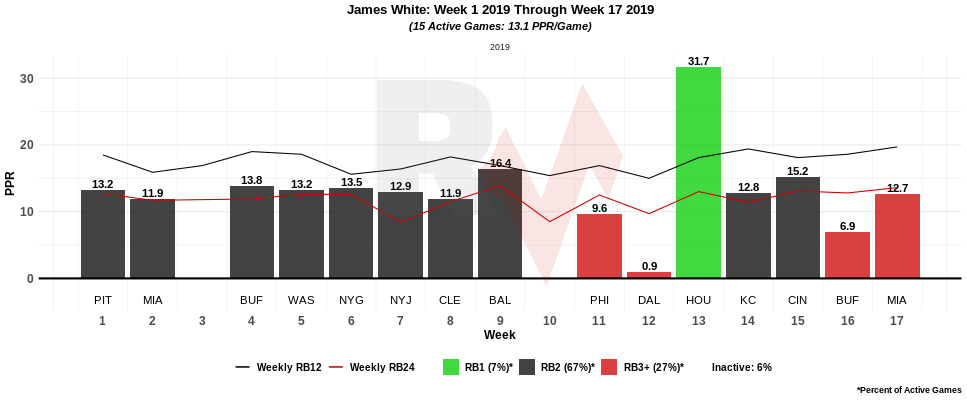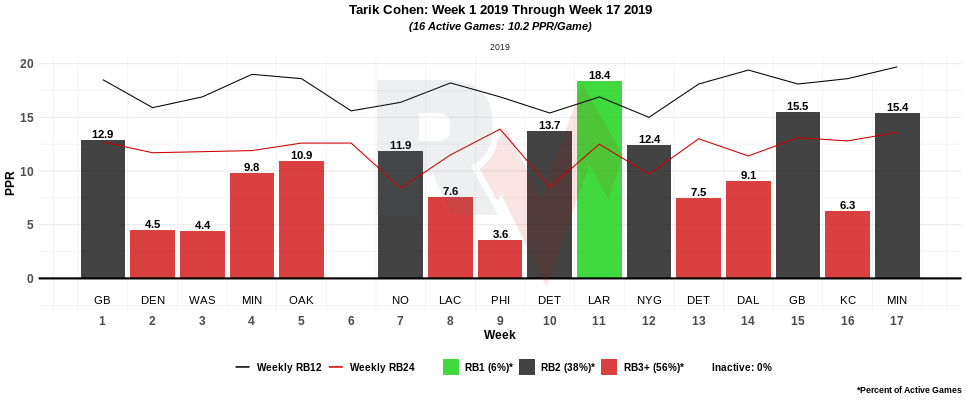
Antonio Losada evaluates four running backs that should become fantasy football draft targets in 2020 given the potential ROI they could generate for their owners based on ADP.
For fantasy football GMs, draft season is gearing up. Preparing for what is waiting for us in our virtual war-rooms is a key part of the process, and the first thing to know is the format of the league we're going to be part of. The difference between Standard and PPR (Point-Per-Reception) scoring systems is really simple, with the latter awarding one extra point to players who catch a pass. Standard scoring was a staple in the early days of fantasy football, but PPR has become the most played system lately.
It doesn't take a genius to know who this benefits the most: over-targeted receivers, pass-catching running backs, and reliable tight ends. While some players are good enough to put up good numbers on their pure talent, others might fall shorter on the ability leaderboard. Some of those, though, trump the most talented ones in fantasy leagues due to a heavier usage and racking up receptions that go for extra fantasy points.
Having the PPR scoring system in mind, it's time to discover which players are surefire bets to excel in leagues following that format that are currently being undervalued in drafts by fantasy GMs. Today, I'm highlighting four running backs who are primed to become studs in these leagues that have lower ADPs and prices than those they should be attached to.
Be sure to check all of our fantasy football rankings for 2025:- 2025 fantasy football rankings (redraft)
- Dynasty fantasy football rankings
- 2025 NFL rookie fantasy football rankings
- Best ball fantasy football rankings
- Quarterback fantasy football rankings
- Running back fantasy football rankings
- Wide receiver fantasy football rankings
- Tight end fantasy football rankings
Nyheim Hines, Indianapolis Colts
ADP 205.5, Projected PPR: 146.2
Even in the two weeks Marlon Mack wasn't active last season, Nyheim Hines couldn't crack the 10-rushing attempts mark logging nine and four in Weeks 12 and 13. That will, once more, be the case this season. Indianapolis will use both Mack and rookie Jonathan Taylor as its RB1 and RB2 on the ground, with Hines profiling as the No. 1 option in the backfield when it comes to the passing game.
Before getting too high on Hines you should know the player we're discussing here. Hines is most probably not going to win you the league. PFF has him projected for 146.2 PPR points in 2020, good for RB58. But keep in mind, though, that we're discussing PPR leagues here and there aren't that many running backs with Hines' upside and abilities when it comes to the passing game. Hines is one of just 11 running backs projected to 49+ receptions and the one projected to log the fewest opportunity share with a really low 14.3%. Just in case, only James White (discussed next) projects to get more PPR points over the year than Hines on a 15% or lower opportunity share.
Hines is a great FLEX option in PPR leagues and if either of Mack or Taylor fall injured he'll boost his numbers as he'll probably be used more on the ground (don't expect a lot on that front, though). Among running backs projected to get at least 100 opportunities in 2020, Hines has the third-highest ROI (ADP divided by final overall rank in PPR leagues) only behind Alvin Kamara and Raheem Mostert at the time of this writing.
James White, New England Patriots
ADP 139.1.7, Projected PPR: 153.8
Every year is the same story. Every year I think James White will be properly valued, and I always find myself on the wrong side of things. We're talking PPR leagues here, and White is basically a wide receiver disguised as a running back. White ranked sixth in targets and receptions, and third in receiving yards among rushers last season, and he's still getting drafted in the 11th round at the earliest.
Did I mention that he finished the year as the RB20 without even reaching 70 rushing attempts? That's White for you in the unknown. It will be hard for White to get more carries (PFF projects him to see 59 in 2020) but the targets and receptions clearly outweigh the rushing numbers. With a 77/58/435/2 (targets/receptions/receiving yards/TDs) projected line for next season, White is one of just eight RBs expected to reach at least a 75/55/435/2 line over the year.
Although not an incredible PPR scorer, White is one of (if not the) most reliable and steady performers in the NFL. Just look at his outcomes from 2019 in the chart above. Not counting his Week 12 dud and his impossibly great performance in Week 13, he would have averaged 12.9 PPG never diverging by more than six PPR points from that mark. Consider White a lock to give you 12 PPR points each and every week with upside to getting into the 20s if everything clicks for him.
Tarik Cohen, Chicago Bears
ADP 139.4, Projected PPR: 155.9
Cohen's profile and his situation in Chicago are incredibly similar to those of White (read above). Actually, PFF has White projected at 153.8 PPR points in 2020 and Cohen to 155.9. On a finer level of detail, White's projected receiving line reads 77/58/435/2 while Cohen's sits at 72/58/456/2. Simply put, these two tailbacks can't be closer in expected production and in ADP with virtually the same value there.
While I'm higher on White than on Cohen, the truth is that the latter brings a little bit more to the equation thanks to his usage on the running game. Cohen projects to get 19.8% of Chicago's rushing attempts (74) in 2020 compared to White's 13.6% (59 attempts). The best thing about White and also Cohen is that both, even playing the RB position, are projected to end next season as the third most-targeted players on their attacks with 16% of the targets going their ways.
Although Cohen had a middling first half in 2019 averaging 8.2 PPG from the first game to Week 9, he raised that average to 12.3 PPG during the last eight games of the season. He scored the 18th-most PPR points in that span thanks mostly to his 45 receptions, third only to Christian McCaffrey's 74 and Alvin Kamara's 48 from Week 10 on. Cohen recently admitted he didn't take care of his body properly last year, so it's possible that he will be recommitted to being better.
Le'Veon Bell, New York Jets
ADP 68.7, Projected PPR: 163.3
Considering Bell undervalued, with an ADP of 88.5 (inside the first six rounds), might be a little too much. But bear with me. Bell's current ADP, compared to where he is projected to finish the year in PPR points (RB14) makes him a very nice bargain. With PFF projecting Bell to reach 226.5 PPR points in 2020, that'd make him the 46th-best player overall in the NFL, thus giving him a ROI of 1.49. That mark is the second-highest among running backs getting drafted inside top-third rounds of 12-team leagues only behind Kamara's 4.1. The return on investment can't get much higher.
The perception of Bell's 2019 season is that of a rusher past his prime, and not a very good one all things considered. That is far from reality, though. Bell finished last year as the RB16 in PPR leagues and although he closed the season on a low-scoring streak he was able to perform as an RB1 in six of the first 11 games he played, and only finished below the RB2 threshold six times in 16 games. Bell is, at the very least, a high-level RB2 with upside to turn into an RB1 in 2020.
Most important for the purposes of this article, though, is the fact that he's one of only nine RBs projected to more than 50 receptions (52) and 65 targets. Bell has it all. He is the No. 1 rusher on his team by a mile (he projects to get 58.2% of the Jets rushing attempts, the ninth-highest mark among all RBs), should reach 800+ yards on the ground, and also has the pass-catching ability to consider him a do-it-all player very valuable in PPR leagues.
More Fantasy Football Analysis
 RADIO
RADIO




























